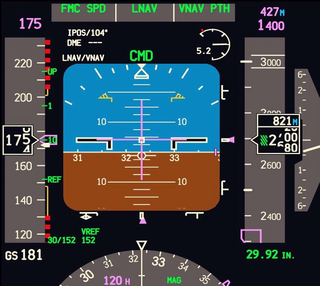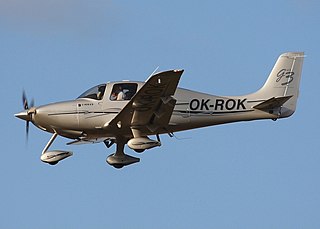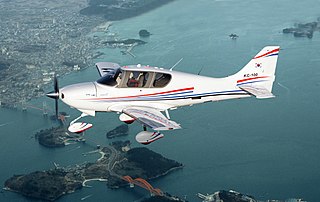
A cockpit or flight deck is the area, usually near the front of an aircraft or spacecraft, from which a pilot controls the aircraft.

A multifunction display (MFD) is a small-screen surrounded by multiple soft keys that can be used to display information to the user in numerous configurable ways. MFDs originated in aviation, first in military aircraft, and later were adopted by commercial aircraft, general aviation, automotive use, and shipboard use.

The Wide Area Augmentation System (WAAS) is an air navigation aid developed by the Federal Aviation Administration to augment the Global Positioning System (GPS), with the goal of improving its accuracy, integrity, and availability. Essentially, WAAS is intended to enable aircraft to rely on GPS for all phases of flight, including precision approaches to any airport within its coverage area. It may be further enhanced with the Local Area Augmentation System (LAAS) also known by the preferred ICAO term Ground-Based Augmentation System (GBAS) in critical areas.

The Piper PA-46 Malibu and Matrix, now known as the M-Class, are a family of American light aircraft manufactured by Piper Aircraft of Vero Beach, Florida. The aircraft is powered by a single engine and has the capacity for one pilot and five passengers. Early Malibus were all piston-engined, but a turboprop version, introduced as the Malibu Meridian but now called the M500, is also available. Currently, Piper offers the M350, M500, and M600 in the PA-46 family.

The Cirrus SR20 is an American piston-engined, four- or five-seat composite monoplane built since 1999 by Cirrus Aircraft of Duluth, Minnesota. The aircraft is the company's earliest type-certified model, earning certification in 1998.
Garmin Ltd. is an American, Swiss-domiciled multinational technology company founded in 1989 by Gary Burrell and Min Kao in Lenexa, Kansas, United States, with headquarters in Olathe, Kansas. Since 2010, the company is legally incorporated in Schaffhausen, Switzerland.

In aviation, an electronic flight instrument system (EFIS) is a flight instrument display system in an aircraft cockpit that displays flight data electronically rather than electromechanically. An EFIS normally consists of a primary flight display (PFD), multi-function display (MFD), and an engine indicating and crew alerting system (EICAS) display. Early EFIS models used cathode ray tube (CRT) displays, but liquid crystal displays (LCD) are now more common. The complex electromechanical attitude director indicator (ADI) and horizontal situation indicator (HSI) were the first candidates for replacement by EFIS. Now, however, few flight deck instruments cannot be replaced by an electronic display.

The Garmin G1000 is an electronic flight instrument system (EFIS) typically composed of two display units, one serving as a primary flight display, and one as a multi-function display. Manufactured by Garmin Aviation, it serves as a replacement for most conventional flight instruments and avionics. Introduced in June 2004, the system has since become one of the most popular integrated glass cockpit solutions for general aviation and business aircraft.

A primary flight display or PFD is a modern aircraft instrument dedicated to flight information. Much like multi-function displays, primary flight displays are built around a Liquid-crystal display or CRT display device. Representations of older six pack or "steam gauge" instruments are combined on one compact display, simplifying pilot workflow and streamlining cockpit layouts.

A flight management system (FMS) is a fundamental component of a modern airliner's avionics. An FMS is a specialized computer system that automates a wide variety of in-flight tasks, reducing the workload on the flight crew to the point that modern civilian aircraft no longer carry flight engineers or navigators. A primary function is in-flight management of the flight plan. Using various sensors to determine the aircraft's position, the FMS can guide the aircraft along the flight plan. From the cockpit, the FMS is normally controlled through a Control Display Unit (CDU) which incorporates a small screen and keyboard or touchscreen. The FMS sends the flight plan for display to the Electronic Flight Instrument System (EFIS), Navigation Display (ND), or Multifunction Display (MFD). The FMS can be summarised as being a dual system consisting of the Flight Management Computer (FMC), CDU and a cross talk bus.

The Cirrus SR22 is a single-engine four- or five-seat composite aircraft built from 2001 by Cirrus Aircraft of Duluth, Minnesota.

A synthetic vision system (SVS) is a computer-mediated reality system for aerial vehicles, that uses 3D to provide pilots with clear and intuitive means of understanding their flying environment.

The Symphony SA-160 is a CAR 523 certified, two-seat, single-engine, high-wing airplane that was manufactured by Symphony Aircraft Industries in Trois-Rivières, Quebec, Canada in the mid-2000s.
Chelton Flight Systems designs and manufactures advanced avionics and flight controls. Based in Boise, Idaho, Chelton Flight Systems originally started out as Sierra Flight Systems. The company was co-founded by Gordon Pratt and Rick Price in 1997. It is part of Genesys Aerosystems since 2014.
Avidyne Corporation is an avionics company based in Melbourne, Florida. Avidyne is developer of Integrated Avionics Systems, multi-function displays, and traffic advisory systems for light general aviation (GA) aircraft. Headquartered in Melbourne, Florida, the company has facilities in Melbourne, as well as Concord, Massachusetts; Columbus, Ohio; and Boulder, Colorado.
Universal Avionics Systems Corporation, also known as Universal Avionics, is an international company headquartered in Tucson, Arizona in the United States. It primarily focuses on flight management systems (FMS) and cockpit instrument displays for private, business, and commercial aircraft. The company has domestic offices in Arizona, Kansas, Washington, and Georgia, and overseas offices in Switzerland.
L-3 SmartDeck - is a fully integrated cockpit system originally developed by L-3 Avionics Systems. and acquired in 2010 by Esterline CMC Electronics through an exclusive licensing agreement.
Localizer performance with vertical guidance (LPV) are the highest precision GPS aviation instrument approach procedures currently available without specialized aircrew training requirements, such as required navigation performance (RNP). Landing minima are usually similar to those of a Cat I instrument landing system (ILS), that is, a decision height of 200 feet (61 m) and visibility of 800 m. Lateral guidance is equivalent to a localizer, and uses a ground-independent electronic glide path. Thus, the decision altitude, DA, can be as low as 200 feet. An LPV approach is an approach with vertical guidance, APV, to distinguish it from a precision approach, PA, or a non-precision approach, NPA. WAAS criteria includes a vertical alarm limit more than 12 m, but less than 50 m, yet an LPV does not meet the ICAO Annex 10 precision approach standard.

The KAI KC-100 Naraon is a South Korean four-seat, low-wing, single-engine light aircraft developed and manufactured by Korea Aerospace Industries (KAI). The name Naraon was chosen based on public input. It has the distinction of being the first civil-orientated aircraft to be developed in South Korea.

Honeywell Primus is a range of Electronic Flight Instrument System (EFIS) glass cockpits manufactured by Honeywell Aerospace. Each system is composed of multiple display units used as primary flight display and multi-function display.














